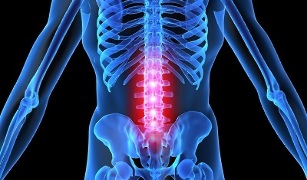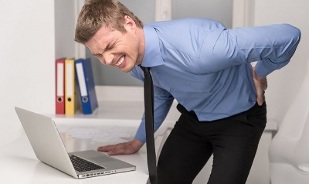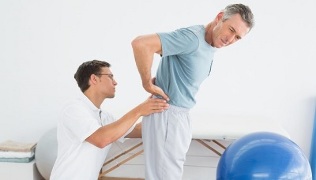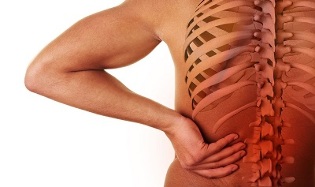Low back pain most often affects people over 35 years of age. In the vast majority of cases, the disease is associated with deformity of the vertebrae and its consequences. A timely visit to the doctor will speed recovery, because the symptoms and treatment of lumbar spine osteochondrosis are interrelated concepts.
The greater the progress of the disease, the more serious its consequences, the more difficult the process of restoring health.
Signs and symptoms of lumbar spine osteochondrosis

The lumbar spine is located between the sacrum and the thoracic region and consists of five vertebrae connected by intervertebral discs.
The development of osteochondrosis means the wearing of the intervertebral discs, which play a shock absorbing role during loads on the spine. The base of the discs is a gelatinous mass, protected by a dense fibrous ring and cartilaginous tissue, and the internal space is filled with a liquid pulpous nucleus.
As the loads on the vertebrae increase, the elasticity and flexibility of the intervertebral discs are lost, as well as their height, and micro-cracks are formed in the fibrous annulus, which ultimately lead to their rupture and injury to the pulpal nucleus.
Tissue destruction is accompanied by pinching of nerve roots located on both sides of the vertebrae and causes severe pain.
The main signs of lumbar osteochondrosis:
- back pain;
- fatigue and depression;
- weakness or excessive muscle tension;
- loss of sensation in the limbs, buttocks or thighs;
- sharp or sore pains and spasms in the lower back, usually radiating to the legs;
- violation of motor function.
In the context of severe injuries of the vertebrae in the lumbar region, other symptoms are observed, in most cases, dysfunctions of other organs - urinary and reproductive system, gastrointestinal tract.
Causes of the occurrence
Like most diseases of the musculoskeletal system, osteochondrosis can develop for several reasons. Some of them are rooted in lifestyle and diet, while the other part develops in the context of the physiological characteristics of the body.
Often, the treatment of osteochondrosis of the lumbosacral spine is required by athletes, whose backs are exposed not only to constant loads of strength, but also to periodic injuries.

The second category of people at risk, people who, by virtue of their profession, spend a lot of time in one position - teachers, hairdressers, cooks, porters, waiters, programmers, office workers and drivers.
Among other reasons for the development of the pathology:
- overweight; metabolic disorder
- ;
- improper posture, stooping;
- genetic predisposition;
- lesions;
- bad habits;
- lack of trace elements and vitamins useful in the diet;
- abnormal development of the musculoskeletal system, flat feet; hypothermia;
- inactivity, static;
- frequent stress.
All of the above factors can affect the elasticity of intervertebral discs, as they contribute to impaired blood circulation or the appearance of nutrient deficiency entering the vertebral tissues.
The vertebrae are able to perform their functions, subject to regular tissue renewal. In case of malnutrition of the vertebral tissues, either due to lack of blood circulation or problems with the metabolism, the regeneration processes slow down or stop completely. Therefore, dryness and dystrophic changes occur in the cartilage and fibrous ring of the vertebrae.
Degrees of lumbar spine osteochondrosis
Depending on the level of the spinal injury, there are four degrees of development of osteochondrical processes, which manifest themselves in stages as the disease progresses.
First degree
Pathological processes in the spine begin long before its first clinical manifestation. As a result of moisture loss, the intervertebral discs become less elastic. The height of the discs remains normal. The patient feels discomfort in the lower back.
High school

In the context of moisture deficiency, microcracks appear in the fibrous ring and tissue inflammation occurs.
The hook-like processes of the vertebrae gradually increase. Seals develop in the cartilage.
A patient complains of back pain radiating to the legs or groin. Limitation of motor skills is possible. Malfunction occurs in the work of internal organs.
Third grade
The integrity of the fibrous ring is broken, the intervertebral disc protrudes, forming a hernia. The vessels and nerve endings are compressed. There are muscle spasms, dysfunction of Organs pelvic organs, sensory disturbances of the lower extremities, prolonged attacks of radiculitis.
Fourth grade
The most difficult, untreatable stage of the disease course. As a result of the complete destruction of the intervertebral discs, scars are formed instead. The vertebrae get as close as possible and gradually deform. With the development of spinal cord compression, paralysis of the lower limbs is possible.
If timely treatment of lumbar spine osteochondrosis is not provided, destruction of the vertebrae will progress and may lead to disability.
Diagnosis
To recognize a disease and determine an accurate diagnosis, neurologists use a set of measures - anamnesis, physiological examination and device studies.
Taking anamnesis
Provides for the study of patient complaints:
- cause for concern;
- location of discomfort;
- duration and intensity of unpleasant sensations;
- the duration of the disease;
- possible causes of the disease;
- frequency of exacerbations;
- factors that cause exacerbations;
- factors that improve well-being.
In addition, the doctor studies information about the patient's lifestyle, food, work and rest, the presence of bad habits, hereditary factors and trauma.
Physiological examination

Performed to identify pathological changes and make a preliminary diagnosis.
During the exam, the doctor assesses the patient's motor skills - gait, posture, range and range of motion. The palpation method examines the state of the muscles - tone, size, volume, presence of spasms.
Sets the level of sensitivity with a slight tingling sensation. Hitting with a hammer allows you to recognize the pain irradiation zones.
Hardware tests
To obtain complete and accurate information about the location of the pathology and the degree of damage to the tissue, doctors use research with various types of medical equipment.
Radiography.Examination of the lumbar spine using X-rays allows the establishment of anatomical parameters of the vertebrae and intervertebral discs, the tendency to narrow the holes between the bases, the presence of bone growth.
Tomography.The use of electromagnetic waves provides an image of the study area on the screen for further study and analysis of the state of the vessels that supply the spinal tissues, nervous processes and intervertebral discs.
CT.X-ray images of various spine segments are obtained. The image is displayed on the monitor to determine the nature of the changes in the vessels, in the membrane of the vertebrae and in the spinal cord, marginal growths.
For differential diagnosis, several types of research are used to exclude pathologies from other systems of the body.
Treatment of lumbosacral spine osteochondrosis
The duration and characteristics of the treatment of lumbosacral osteochondrosis depend on the results of the diagnostic measures. In the early stages of disease development, conservative treatment is indicated. For more complex injuries of the spine, surgical intervention is used.
The ideal therapeutic effect is achieved through complex therapy, which includes the use of topical medications, physiotherapy, massage and physical exercises.
Medication
To relieve symptoms, non-steroidal medications are prescribed for internal and external use - pills, injections, ointments. In addition, chondroprotectors, neuroprotectors, diuretics, vitamins and muscle relaxants are used.

The medication allows:
- eliminates pain;
- relieves inflammation;
- relax your muscles;
- restores the destroyed cartilage tissue;
- improves blood circulation;
- reduces swelling;
- increases physical activity;
- normalizes brain nutrition.
For acute pain, novocaine block is used, providing instant action.
Folk remedies
Traditional treatment is effective as a complement to drug therapy. The main methods of traditional medicine are based on the use of plant materials, animal products and chemicals.
Based on various components, ointments and compresses, decoctions and infusions are prepared for internal and external use, as well as for medicinal baths.
Physiotherapy for lumbar osteochondrosis
Physiotherapy procedures are an excellent way to restore the motor functions of the spine after suffering from osteochondrosis.
The main methods of physiotherapy are:
- electrotherapy- exposure to weak electrical currents to improve blood circulation in tissues;
- magnetotherapy- the use of the properties of the magnetic field to restore tissue at the cellular level;
- laser therapy- complex activation of biological processes in vertebral tissues and nerve endings;
- shockwave therapy- improved microcirculation and metabolic processes in tissues affected by exposure to an acoustic wave;
- balneoterapia- using the healing properties of mineral water.
Physiotherapy procedures not only increase the effectiveness of drug treatment several times, but also contribute to healing and strengthening the body as a whole.
Massage for lower back osteochondrosis
Visiting massages is one of the most pleasant and effective methods of treating osteochondrosis.
With massage therapy:
- eliminates muscle spasms;
- improves the blood supply to the affected areas;
- improves lymphatic flow;
- restores atrophied muscles;
- removes the mobility limitation.
Massage is prescribed when pain syndromes are eliminated.
Corrective Gymnastics
The main task of exercise therapy in osteochondrosis is to restore the functionality of the spine and correct it. However, you can only attend classes after eliminating the symptoms of exacerbation.
The most effective methods of medical gymnastics are:
- loading;
- visit to the academy;
- hydrotherapy, swimming.
A rack can be used for sports at home. Some doctors recommend yoga to their patients to restore spine flexibility.
Exercises to exacerbate lumbar osteochondrosis
Any exercises for osteochondrosis should be performed slowly and without sudden movements.
To strengthen the muscles that support the vertebrae, appropriate exercises performed while lying face down. In this case, the arms are pulled upwards with a slight stretch, but without tension. Repeat 4 times.
Surgery
Surgery is used to treat the spine in especially difficult cases - with significant neurological disorders, as well as with loss of stool control.
During surgery, the source of the disease is removed and steps are taken to stabilize the spine. The postoperative period lasts several months.
Why is lumbar osteochondrosis dangerous?

The degenerative changes that occur in lumbar osteochondrosis contribute to the development of many potentially fatal diseases. In the context of an intervertebral hernia, protrusions, lumbago and sciatica occur.
The progress of the disease can cause prolapse of the intervertebral disc and the formation of spinosis. In addition to the intense pain that accompanies the pathology, a person's motor abilities are interrupted, until his total loss. Paralysis of the lower limbs develops.
Death is inevitable in the event of significant damage to the lining of the spinal cord.
Prevention
To avoid devastating spinal changes, you need to take care of a healthy lifestyle:
- plays sports - swimming, temperament;
- to adhere to a correct nutritious and balanced diet;
- eliminates bad habits;
- maintain posture;
- support your spine while sleeping with an orthopedic mattress.
In addition, it is advisable to avoid hypothermia, weight lifting. Women are advised not to wear high heels frequently.
You can maintain your lower back health by adjusting your lifestyle and not forgetting the importance of physical activity.





































